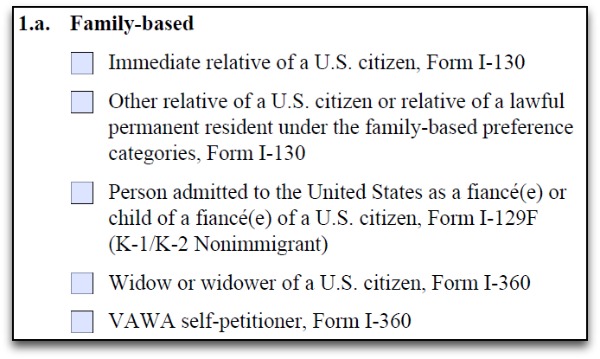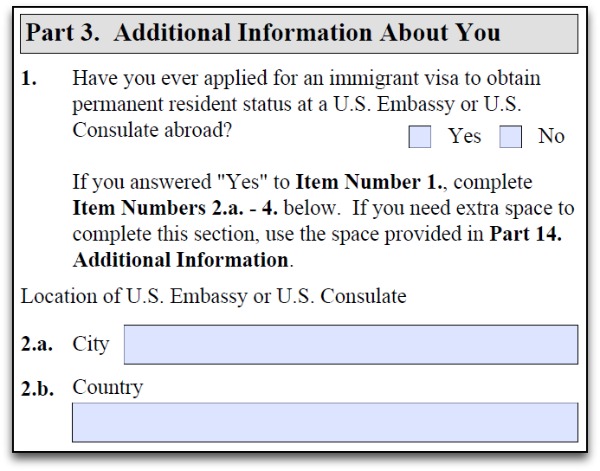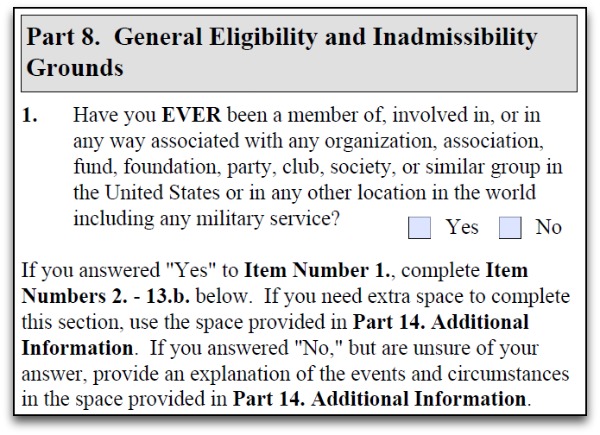
Intending immigrants who want to prepare Form I-485, Application to Register Permanent Residence or Adjust Status, face a challenge. The Form I-485 instructions can be extraordinarily intimidating. After all, there are 44 pages of instructions for the green card application. What’s more, other forms are typically filed concurrently as a part of the adjustment of status package. In some cases, an innocent mistake can result in significant delays, long-term immigration problems, or even an I-485 denial.
Form I-485 Instructions by Part
Part 1: Information About You
Part 2: Application Type or Filing Category
Part 3: Additional Information About You
Part 4: Information About Your Parents
Part 5: Information About Your Marital History
Part 6: Information About Your Children
Part 7: Biographic Information
Part 8: General Eligibility and Inadmissibility Grounds
Part 9: Accommodations for Individuals With Disabilities and/or Impairments
Part 10: Applicant Signature
Part 11: Interpreter Signature
Part 12: Preparer Signature
Part 13: Signature at Interview
Supporting Document Checklist
I-485 Filing Instructions Made Easier
Options for Preparing Form I-485
With a significant USCIS fee increase on the horizon and legal fees at an all time high, applying for a green card has been a very expensive process. Depending on the case, attorneys may charge $2,500-$10,000 (not including USCIS fees) to file an adjustment of status application package. For individuals with complex situations, criminal offenses, or serious immigration violations, using an lawyer is the best option. But most people with straight-forward situations don’t need a lawyer.
That’s why CitizenPath created an affordable solution for preparing Form I-485 and the entire adjustment of status application package. The online immigration service was designed by experienced immigration attorneys for people with straight-forward cases. It even allows our customers to prepare Form I-130, Petition for Alien Relative (and Form I-130A) at the same time if needed. The service makes the process easy and provides alerts if we detect a problem. And we guarantee that USCIS will approve your application… or your money back. Maybe best of all, you'll get easy-to-use I-485 filing instructions. We customize the filing instructions to your answers in the application. You'll get a checklist of items to include in your application package. It’s free to get started. You don’t pay for our service until you’re done. Try it now >>
Form I-485 Instructions
We compiled some basic step-by-step I-485 instructions for your convenience. We’ve skipped over simple items and focused on the areas the most people need help. When preparing your I-485 application on CitizenPath, you’ll find more extensive directions.
Part 1: Information About You
For Your Current Legal Name, use the name that appears on your passport, unless you have changed it. For example, you may use your new married name if your recent marriage legally changed your name. You’ll need to submit a copy of the marriage certificate as evidence of the name change.

In Other Names, provide any other names, including a maiden name, that you have used during your life.
Always use a Mailing Address where you can reliably receive mail from USCIS. Certain applicants who are victims of crime or abusive situations may use an Alternate and/or Safe Mailing Address. You may use a Post Office box or other mail box service. If you receive mail at someone else’s home, enter that person’s name in the “In Care Of” line.
Your Place of Last Arrival into the United States is generally the port of entry where you were inspected by a U.S. Customs and Border Protection (CBP) officer. It can be an airport, seaport or land border crossing. However, it should be a U.S. location. So if you were inspected by U.S. immigration officials in another country, use the location where you actually entered the United States. Generally, you must have a lawful entry. This means that you had valid documentation (i.e. visa, refugee status, etc.) and made face-to-face contact with the CBP officer. However, at some border entries, visitors may be “waved” across while in their cars. This also counts as a lawful entry as long as you had the proper documentation (e.g. Canadian passport).
Your Form I-94 Arrival-Departure Record Number is typically an important part of the application. Most people can find their 11-digit I-94 Arrival-Departure Record and other particulars on the I-94 Website. Asylees, refugees, or applicants who entered through a land border crossing may be provided with a paper-based Form I-94 instead. Mexican and Canadian visitors who entered through a land border crossing generally do not receive an I-94 record. Only certain classes (such as immediate relatives) may adjust status if the “Expiration Date of Authorized Stay” is in the past. For example, the spouse of a U.S. citizen can adjust status after a visa overstay. If you are unsure, use CitizenPath or speak to an immigration attorney before proceeding.
Part 2: Application Type or Filing Category
Check only one box that indicates the Application Type or Filing Category. At this point, you’ll need to understand the basis of your eligibility. Most people adjust status through a family-based category. Determine if you are an immediate relative or family-based preference category. Foreign spouses who entered on a K-1 visa (or their K-2 dependents) would apply in their own category.

The vast majority of applicants do not apply for adjustment based on the Immigration and Nationality Act (INA) section 245(i). You can likely skip this checkbox because it is for certain applicants who entered unlawfully.
If you are filing Form I-485 concurrently with the visa petition, you may skip Information About Your Immigrant Category. On the other hand, you’ll need to provide details about your pending or approved visa petition if it was previously filed. Depending on your application type, the visa petition could be Form I-129F, I-130, I-140, I-360, I-589, I-590 or I-730.
Most people are principal applicants. A derivative applicant is an intending immigrant who cannot be directly petitioned for, but who can acquire the ability to adjust status through the principal applicant. The spouse and/or unmarried child (under the age of 21) of an applicant generally receive the same or similar immigration benefits (green card) as the principal.
Part 3: Additional Information About You
Indicate if you have ever applied for an immigrant visa to obtain permanent resident status at a U.S. embassy or consulate. Be careful. Filing a petition (such as Form I-130) is not the same as applying for an immigrant visa. Generally, applying for an immigrant visa means you filed Form DS-260. If you have ever been refused or denied a visa, understand the reason why and how it may affect your current application. Speak to an immigration attorney if necessary.

According to the I-485 instructions, you should provide five years of Address History and Employment History (inside or outside the United States). Enter complete addresses and relevant dates. Estimate the date to the best of your ability if you cannot remember the exact date. If you need extra space, you’ll need to add the other records to Part 14 Additional Information on the last page. USCIS will use this information to do a background check. Employment is not a requirement for eligibility. Indicate “Unemployed” if you have not worked during any period. However, if you’ve been employed inside the United States, be sure that you were authorized to work. For certain applicants, unauthorized employment is sufficient reason to deny Form I-485.
Part 4: Information About Your Parents
Provide information about your parents. This information will be used for a background check. If the information is unknown or your parent is deceased, you may indicate so.
Part 5: Information About Your Marital History
Most of this section should be self-explanatory. Its importance is elevated if you are applying for permanent residence on the basis of marriage. In particular, you’ll want to provide accurate information about your current and former spouses (if applicable) and provide evidence that any previous marriages have ended.
Part 6: Information About Your Children
Provide details about all of your living children, regardless of age. As per the Form I-485 instructions, children includes biological, step and adopted sons and daughters. Even if your children will not be immigrating, list them here. If they are adjusting status, you will need to file separate applications for each child.
Part 7: Biographic Information
USCIS uses this information for identification and statistical information. As you may have noticed, Hispanic/Latino is provided as a choice for ethnicity, but it is not provided as a choice for race. This is because USCIS (and the U.S. government) do not define Hispanic/Latino as a race. For race, you must choose one or more of the values provided in the list. There is no wrong answer. You may answer the question with the race(s) you most closely identify.
Adjustment applicants with origins from Cuba, Mexico, Puerto Rico, South or Central America, or any other Spanish culture or origin should choose the race(s) that fits best for your situation. Many Hispanic applicants select “white” but others choose “black” or “American Indian.” (You may choose more than one.) There is no one single answer that works for all Hispanic people. The answer is individual to you.
Part 8: General Eligibility and Inadmissibility Grounds
There are a variety of ways that USCIS can find an intending immigrant to be “inadmissible” to the United States. Part 8 covers this topic. The questions are generally associated with the grounds of inadmissibility for permanent residence. Take your time to carefully read each question. Generally, a "Yes" answer is problematic in the section, but there are many valid reasons to answer "Yes" that will not negatively affect your application. Misrepresentation, or lying, can definitely be harmful to your case. If you don't feel that you can be honest, it's a good indicator that you speak to an attorney.
List your present and past membership in or affiliation with all organizations in the United States or any other country. Include any military service. Examples include religious organizations, professional associations, political groups and social clubs. USCIS may evaluate your affiliations with certain organizations that may be illegal or against the general principles of American democracy. Use your best judgement to determine if your involvement with a group or organization conflicts with these principles.

You should answer every question honestly and accurately. If you believe a truthful answer could create a problem on the application or you are unsure of your answer, speak to an immigration attorney before filing Form I-485.
Part 9: Accommodations for Individuals With Disabilities and/or Impairments
USCIS will provide reasonable accommodations for qualified individuals with disabilities and impairments that will help them fully participate in USCIS programs and benefits. Reasonable accommodations will vary based on each individual’s disability or impairment. If you believe that you need USCIS to accommodate your disability and/or impairment, indicate “Yes” where applicable and describe the accommodation you require.
Part 10: Applicant's Statement, Contact Information, Declaration, Certification, and Signature
Indicate if you have prepared Form I-485 on your own or through the assistance of an interpreter and/or preparer. Even if a family member or friend prepared the application, you should indicate here. Provide information so that USCIS can contact you. Although it’s unlikely that USCIS will contact you by phone, they will provide communication by email. After reviewing the application for accuracy, the applicant will sign here. The applicant will only sign in this part.
Part 11: Interpreter's Contact Information, Certification, and Signature
Although speaking English is not a requirement for permanent residence, understanding the application and your I-485 instructions is vital. If you have received assistance from an interpreter, provide the interpreter’s information in this part. The interpreter must also sign this part.
Part 12: Contact Information, Certification, and Signature of Person Preparing this Application, If Other Than the Applicant
Do not fill in this section if you prepared the application yourself. On the hand, provide the preparer’s information if another person – even a non lawyer -- prepared the application for you. The preparer must also sign this part.
Part 13: Signature at Interview
Do not fill in this section or sign it now. The USCIS officer will have you sign it during your interview.
Supporting Documents Checklist
There are typically several forms and supporting documents that you must submit with your adjustment of status application. Although the I-485 instructions cover this information, it can be extraordinarily confusing. That’s why CitizenPath provides customized filing instructions for every applicant. Based on your answers in the adjustment of status application, we personalize your filing instructions so that you know exactly which documents to submit. We even provide cover letter templates and instructions on how to organize your adjustment of status package. Learn more about CitizenPath
I-485 Filing Instructions Made Even Easier
CitizenPath provides simple, affordable, step-by-step guidance through USCIS immigration applications like Form I-485, Application to Adjust of Status. We'll make the I-485 filing instructions even easier. In fact, if you're preparing Forms I-130, you'll be able to do it simultaneously to make sure everything is consistent.
Individuals, attorneys and non-profits use CitizenPath to prepare immigration forms accurately, avoiding costly delays and denials. CitizenPath allows users to try the service for free and provides a 100% money-back guarantee that USCIS will approve the application or petition. We provide support for the Adjustment of Status Application Package (Form I-485), Affidavit of Support (Form I-864), and several other immigration services.
Want more immigration tips and how-to information for your family?
Sign up for CitizenPath’s FREE immigration newsletter and
SAVE 10%
on our immigration services





